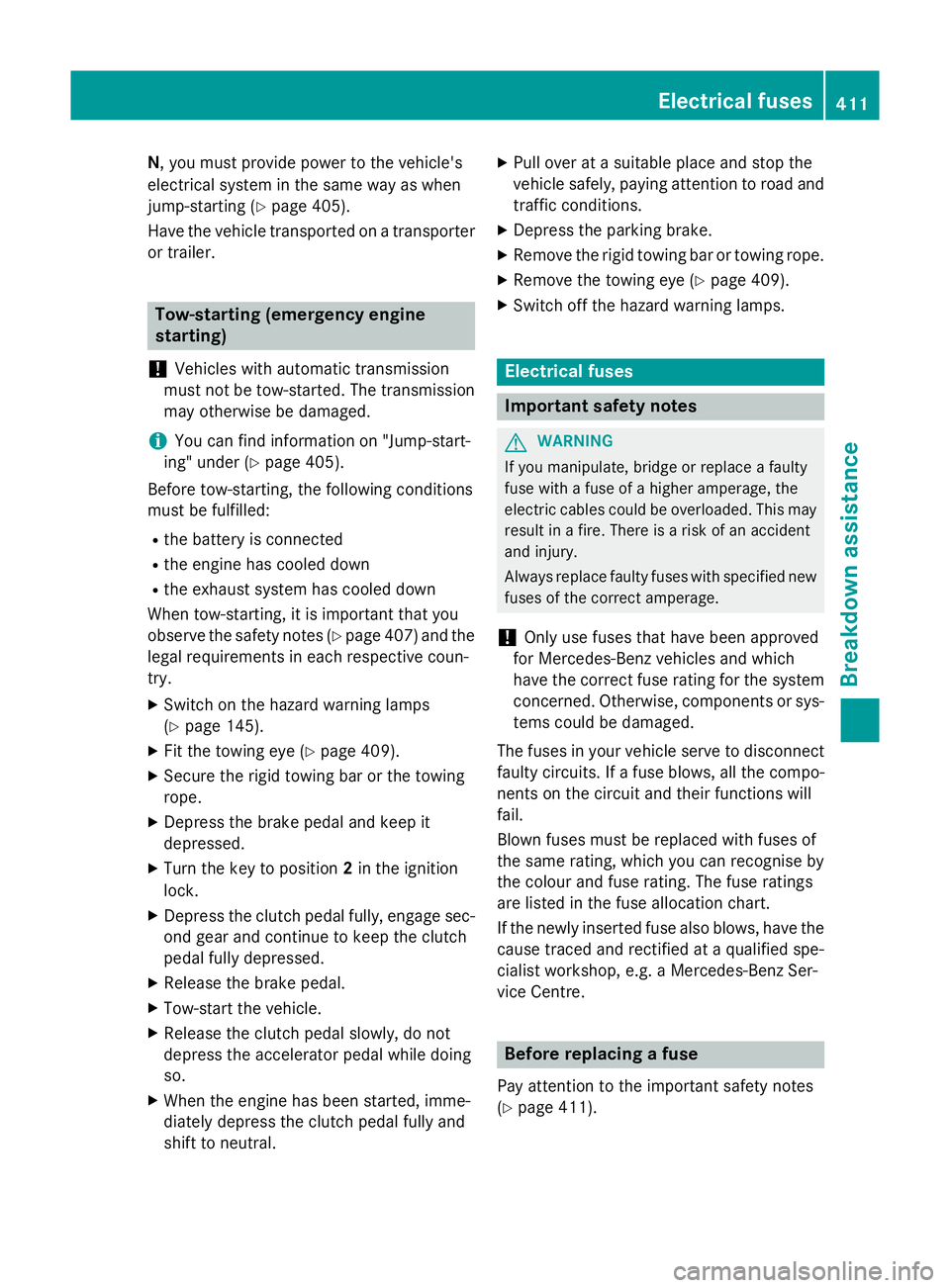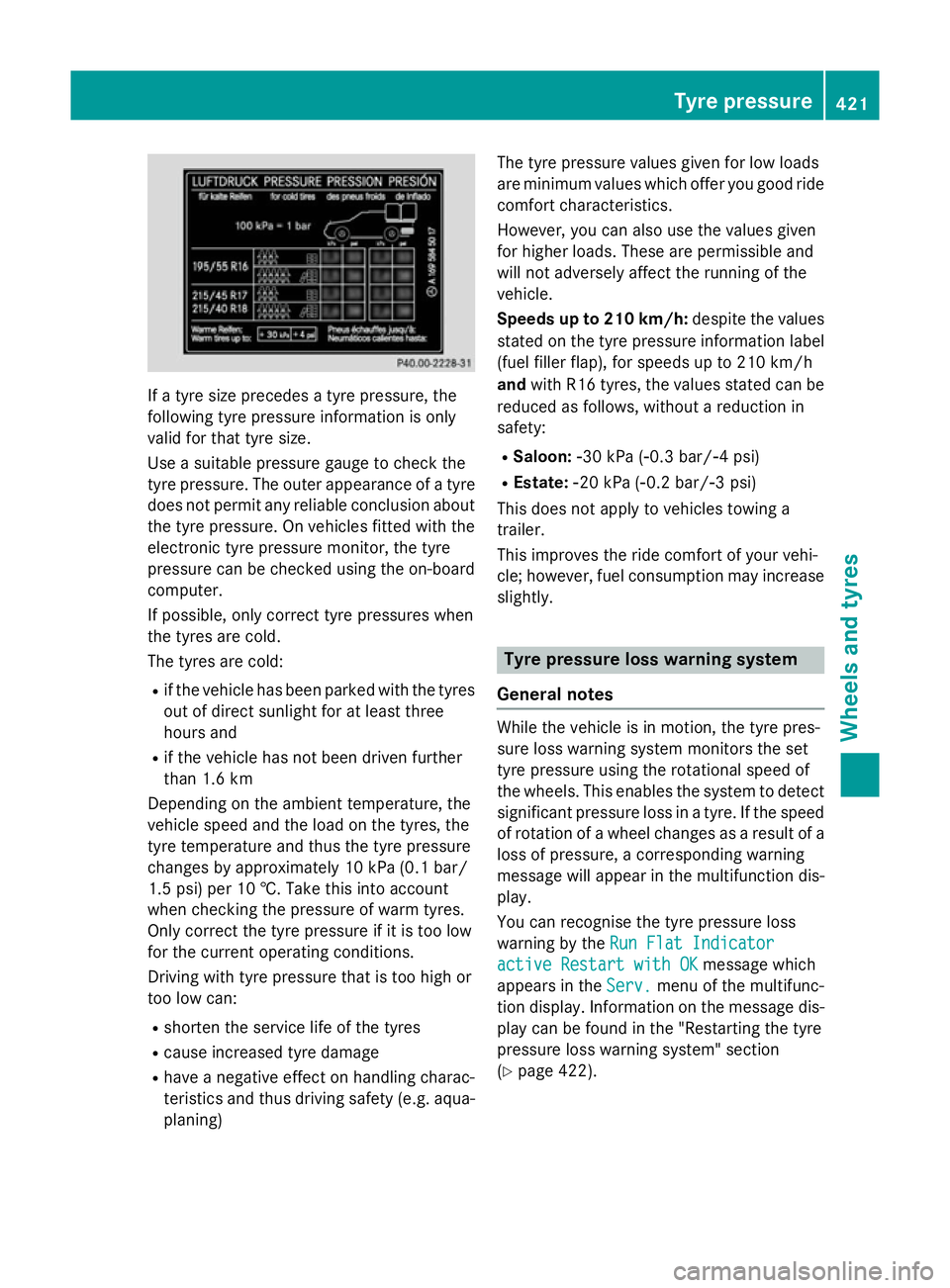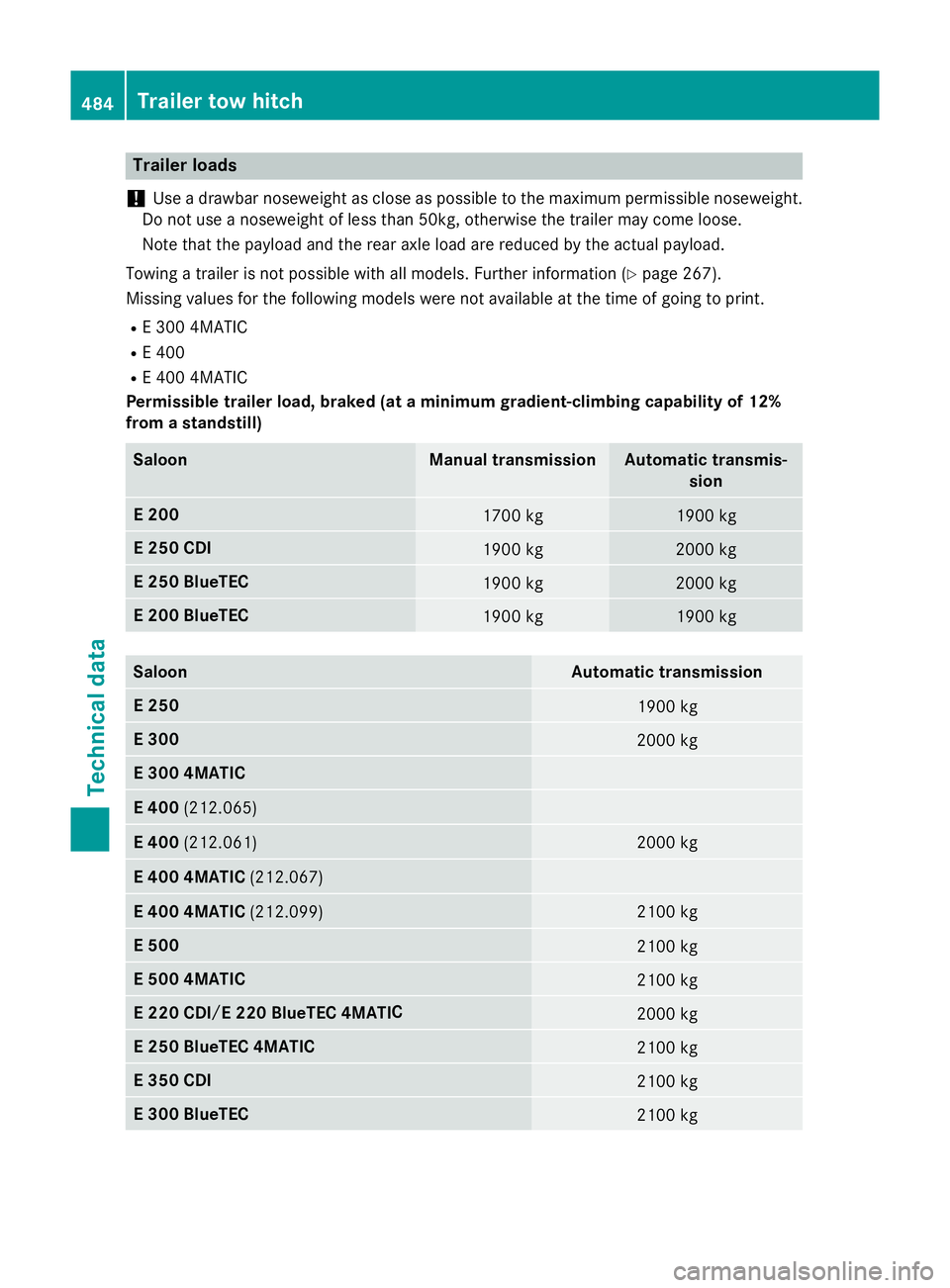Page 414 of 497

N,y
ou must provide power to the vehicle's
electrical system in the same way as when
jump-startin g(Ypage 405).
Have the vehicle transported on atransporter
or trailer. Tow-starting (emergency engine
starting)
! Vehicles with automatic transmission
must not be tow-started. The transmission
may otherwise be damaged.
i You can find information on "Jump-start-
ing" under (Y page 405).
Before tow-starting, the following conditions
must be fulfilled:
R the battery is connected
R the engin ehas cooled down
R the exhaust system has cooled down
When tow-starting, it is important that you
observ ethe safet ynotes (Y page 407) and the
legal requirementsine ach respective coun-
try.
X Switch on the hazard warnin glamps
(Y page 145).
X Fit the towin geye (Y page 409).
X Secure the rigid towin gbar or the towing
rope.
X Depress the brake pedal and keep it
depressed.
X Turn the key to position 2in the ignition
lock.
X Depress the clutc hpedal fully, engage sec-
ond gear and continue to keep the clutch
pedal fully depressed.
X Release the brake pedal.
X Tow-start the vehicle.
X Release the clutc hpedal slowly, do not
depress the accelerator pedal while doing
so.
X When the engin ehas been started, imme-
diately depress the clutc hpedal fully and
shift to neutral. X
Pull over at asuitable place and sto pthe
vehicle safely, paying attention to road and
traffic conditions.
X Depress the parkin gbrake.
X Remove the rigid towin gbar or towin grope.
X Remove the towin geye (Y page 409).
X Switch off the hazard warnin glamps. Electrical fuses
Important safet
ynotes G
WARNING
If you manipulate, bridge or replace afaulty
fuse with afuse of ahigher amperage, the
electric cables could be overloaded. This may result in afire. There is arisk of an accident
and injury.
Always replace faulty fuses with specified new fuses of the correct amperage.
! Only use fuses that have been approved
for Mercedes-Benz vehicles and which
have the correct fuse ratin gfor the system
concerned. Otherwise, components or sys-
tem scould be damaged.
The fuses in your vehicle serv etodisconnect
faulty circuits. If afuse blows, all the compo-
nents on the circuit and their function swill
fail.
Blown fuses must be replaced with fuses of
the same rating, which you can recognise by
the colour and fuse rating. The fuse ratings
are listed in the fuse allocation chart.
If the newly inserted fuse also blows, have the
cause traced and rectified at aqualified spe-
cialist workshop, e.g. aMercedes-Benz Ser-
vice Centre. Befor
ereplacing afuse
Pay attention to the important safet ynotes
(Y page 411). Electrical fuses
411Breakdown assistance Z
Page 424 of 497

If
at yre size precedes atyre pressure, the
following tyre pressure information is only
validf or that tyre size.
Use asuitable pressure gauge to check the
tyre pressure. The outer appearance of atyre
does not permit any reliable conclusion about the tyre pressure. On vehicle sfitted with the
electronic tyre pressure monitor, the tyre
pressure can be checked using the on-board
computer.
If possible, only correct tyre pressures when
the tyres are cold.
The tyres are cold:
R if the vehicle has been parked with the tyres
out of direct sunlight for at least three
hours and
R if the vehicle has not been driven further
than 1.6 km
Depending on the ambient temperature ,the
vehicle speed and the loadont he tyres, the
tyre temperature and thus the tyre pressure
changes by approximately 10 kPa (0. 1bar/
1.5 psi )per 10 †. Take this into account
when checking the pressure of warm tyres.
Only correct the tyre pressure if it is too low
for the current operating conditions.
Driving with tyre pressure that is too high or
too low can:
R shorten the service life of the tyres
R cause increased tyre damage
R have anegative effect on handling charac-
teristics and thus driving safety (e.g. aqua-
planing) The tyre pressure values given for low loads
are minimum values which offer you good ride
comfort characteristics.
However, you can also use the values given
for higherl oads. These are permissible and
willn ot adversely affect the running of the
vehicle.
Speeds up to 210 km/h: despite the values
stated on the tyre pressure information label (fuel filler flap), for speedsupt o210 km/h
and with R16 tyres, the values stated can be
reduced as follows, withou tareduction in
safety:
R Saloon: Ò30 kPa (Ò0.3 bar/Ò4p si)
R Estate: Ò20 kPa (Ò0.2 bar/Ò3p si)
This does not apply to vehicle stowing a
trailer.
This improves the ride comfort of yourv ehi-
cle; however, fuel consumption may increase slightly. Tyre pressure lossw
arning system
General notes Whilet
he vehicle is in motion, the tyre pres-
sure loss warning system monitors the set
tyre pressure using the rotational speed of
the wheels. This enables the system to detect significant pressure loss in atyre. If the speed
of rotation of awhee lchanges as aresultofa
loss of pressure, acorresponding warning
messag ewilla ppear in the multifunction dis-
play.
You can recognise the tyre pressure loss
warning by the Run Flat Indicator Run Flat Indicator
active Restart with OK
active Restart with OK messagewhich
appears in the Serv.
Serv.menu of the multifunc-
tion display.I nformation on the messag edis-
playc an be found in the "Restarting the tyre
pressure loss warning system" section
(Y page 422). Tyre pressure
421Wheelsand tyres Z
Page 487 of 497

Trailer loads
! Use
adrawbar noseweight as close as possibl etothe maximum permissibl enoseweight.
Do not us eanoseweight of less tha n50kg, otherwis ethe trailer ma ycome loose.
Note tha tthe payloa dand the rea raxlel oa da rereduce dbythe actual payload.
Towing atrailer is not possibl ewitha llmodels. Further informatio n(Ypage 267).
Missing values for the following model sweren ot availabl eatthe time of going to print.
R E3 00 4MATIC
R E4 00
R E4 00 4MATIC
Permissibl etrailer load, braked (at aminimum gradient-climbing capability of 12%
fro mas tandstill) Saloon Manual transmission Automati
ctransmis-
sion E2
00 1700 kg 1900 kg
E2
50 CDI 1900 kg 2000 kg
E2
50 BlueTEC 1900 kg 2000 kg
E2
00 BlueTEC 1900 kg 1900 kg
Saloon Automati
ctransmission E2
50 1900 kg
E3
00 2000 kg
E3
00 4MATIC E4
00 (212.065) E4
00 (212.061) 2000 kg
E4
00 4MATIC (212.067) E4
00 4MATIC (212.099) 2100 kg
E5
00 2100 kg
E5
00 4MATIC 2100 kg
E2
20 CDI 2000 kg
E2
50 BlueTEC 4MATIC 2100 kg
E3
50 CDI 2100 kg
E3
00 BlueTEC 2100 kg484
Trailer tow hitchTechnica
ldata E2
20 BlueTEC 4MATI C
/
Page 491 of 497
Saloon Automatic transmission
E5
00 4MATIC 84 kg
E2
20 CDI 84 kg
84 kg
E3
50 CDI 84 kg
E3
00 BlueTEC 84 kg
E3
50 BlueTEC 84 kg
E3
50 BlueTEC 4MATIC 84 kg
Maximumd
rawbar noseweight (the drawbar noseweight is not included in the trailer
load) Estate Manual transmission Automatic transmis-
sion E2
00 84 kg 84 kg
E2
50 CDI 84 kg 84 kg
E2
50 BlueTEC 84 kg 84 kg
E2
00 BlueTEC 84 kg 84 kg
E2
20 BlueTEC 84 kg 84 kg
Estate Automatic transmission
E2
50 84 kg
E4
00 (212.265) 84 kg
E4
00 (212.261) 84 kg
E4
00 4MATIC (212.267) 84 kg
E4
00 4MATIC (212.299) 84 kg
E5
00 84 kg
E5
00 4MATIC 84 kg
84 kg
E3
00 BlueTEC 84 kg
E3
50 BlueTEC 84 kg
E3
50 BlueTEC 4MATIC 84 kg488
Trailer tow hitchTechnical data E2
50 BlueTEC 4MATIC
E2 20 BlueTEC 4MATI C/
E2 50 BlueTEC 4MATIC
E2 20 BlueTEC 4MATI C/
Page:
< prev 1-8 9-16 17-24